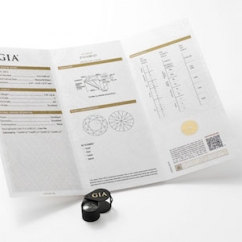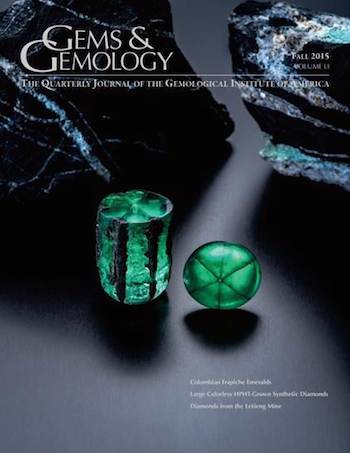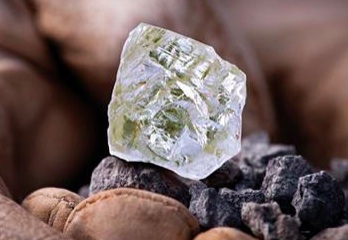Articles and News
Industry News: Few Diamonds Returned To GIA For Re-Grading; Industry Summit Registration Open; More December 02, 2015 (0 comments)

GIA Continues Investigation Into Database Hack; So Far, Few Diamonds Returned For Re-Evaluation
Carlsbad, CA—GIA continues to work closely with its database support contractor TCS and the Indian police to further the investigation of a cyber-driven fraud against the trade. 1,042 grading reports were invalidated following the discovery of an online security breach earlier this fall; GIA has offered a no-cost confirmation service for any diamonds in those reports, but to date fewer than 20% of impacted stones have been returned for re-grading.
The two former TCS employees who made the unauthorized changes to the GIA grading information database were arrested and GIA has suspended the client accounts through which the diamonds in question were submitted. The police investigation continues; GIA will share new information about the investigation that arises.
To address concerns in the trade following the announcement of the invalidated reports, GIA is offering a no-cost confirmation service for any diamond grading report originally issued from November 2014 through October 2015. Anyone with a GIA grading report originally issued in that timeframe who is concerned about the accuracy of the report may submit the original report and the referenced diamond to any GIA location for a confirmation service at no charge. The no-cost confirmation service will be available until Jan. 30, 2016. The diamond and original report must be submitted together using the service name ‘confirmation service’ to obtain the no-fee invoice.
The 1,042 invalidated reports are a very small percentage of the diamond grading reports issued by GIA from November 2014 through October 2015. To date, only 175 of the diamonds with altered reports have been returned to GIA for examination. GIA says it is imperative that all of the diamonds and their reports be returned to GIA for examination to remove the fraudulently altered reports from the market.
“The diamond trade must hold those who would commit such fraudulent acts accountable for their actions. The cooperation of the trade is vital as GIA works to fully address this fraud,” says a GIA statement.
GIA will continue to focus on building consumer confidence and trust by making public any effort by any individual, company or organization to defraud the trade or consumers.
Separately, GIA’s Fall 2015 issue of its Gems & Gemology professional journal features Colombia’s one-of-a-kind trapiche emeralds, plus an article about recent developments in colorless to near-colorless HPHT-grown synthetic diamonds. The renaissance of the Let¹eng-la-Terae diamond mine in Lesotho also is explored as is a study of the origin of white nephrite jade.

G&G’s free archive contains every issue from 1934 to present, more in-depth coverage, hundreds of additional photos, and exclusive video footage. Click here.
Jewelry Industry Summit Debuts Updated Website; Opens Registration
New York, NY—The Jewelry Industry Summit, an open forum on sustainability and responsible sourcing, has debuted its updated website, www.jewelryindustrysummit.com, for registration and details on the event. The Summit will be held March 11-13 at the Fashion Institute of Technology in New York. An opening reception will be held the evening of March 10.
"Consumers care about where their products are sourced today, there's no longer any question. That means it's important to the future health of all of our businesses," says Lita Asscher, president of Royal Asscher and a member of the planning committee for the Summit. "Though there are a number of excellent responsible sourcing programs out there, there's never been an industry-wide consensus on what constitutes a vision all stakeholders can support. The Summit is organized to hear all viewpoints, from miners to retailers. It will also include companies representing all products, from diamonds, colored gemstones, and precious metals, to finished jewelry and timepieces."
The Summit will be an interactive, working meeting, with large and small discussion groups assisted by professional facilitators rather than a full agenda of speakers. With its central purpose of attendee participation, the format contrasts with many other conferences. The planning committee includes members from all sectors of the industry, including diamond and gem companies and retailers. Click here for a list.
"We are interested in hearing from diverse and new voices," says Eric Braunwart, president of Columbia Gem House. "We welcome and encourage participation by companies and individual business owners who want to define what responsible sourcing means, become informed about programs that exist, and discuss if supply chain improvements could be made. We want to spread the word that responsible sourcing isn't just about doing good, it's a smart business move, too.
“Our goal is to align all segments of the industry, both in the U.S. and overseas. We will count the Summit a success if we get new commitments to a vision of responsible sourcing that allows all companies to take part and take action."
Also attending the Jewelry Industry Summit will be government representatives, non-governmental organizations (NGOs), consumer and marketing experts, and affiliated service providers such as banks and industry trade associations. Experts on responsible sourcing will be invited to create informative posters on responsible sourcing issues, which will be featured in a posters area of the Summit meeting space. Summit participants can do advance reading before the event on legal requirements, voluntary standards, association and company practices, and other initiatives in the responsible sourcing field.
Summit registration is $400, with a $50 discount for members of various trade associations. Registration includes admittance to JA New York's spring show, MJSA Expo New York, and Lueur, an antique jewelry show. All three shows commence on Sunday, March 13 at the Javits Center in New York. To register, click here.
Sponsors to date include ABN Amro bank, CIBJO the World Jewellery Confederation, the JA New York Show, and the World Gold Council. Crowd-funding online also raised money from individuals. Additional sponsors are needed; contact Summit administrator Suzan Flamm, suzan@jvclegal.org or view sponsorship opportunities here.
SSEF Announces Upgraded Synthetic Detection Device
Basel, Switzerland—The Swiss Gemmological Institute SSEF has released an upgraded version of its Automated Spectral Diamond Inspection (ASDI) device. The system is designed to support the diamond industry against the threat of small synthetic diamonds mixed into parcels of natural colorless melée diamonds. The device is available for international export.
ASDI is able to conclusively identify colorless natural diamonds by sorting out both HPHT and CVD colorless synthetic diamonds, as well any colorless HPHT-treated diamonds that may be included in a parcel. It is the only automated system that can examine large numbers of melee, as small as 1 mm (0.4 points), at high speed and low cost.
The ASDI device is being marketed and distributed worldwide by SATT Gems SA, which was established in 2014 specifically for that purpose by SSEF.
Rio Tinto Finds 187.7-ct. Canadian Diamond
Northern Territories, Canada—Rio Tinto has unveiled The Diavik Foxfire, a 187.7 carat gem-quality rough diamond discovered at the Diavik diamond mine near the Arctic Circle. The diamond, one of the largest ever discovered in Canada, was showcased during an exclusive preview at Kensington Palace in London.
Rio Tinto Diamonds managing director Jean-Marc Lieberherr said, “We are delighted to showcase this exceptional, two billion-year-old Canadian diamond. Its ancient beginnings, together with the fortitude, finesse and innovative technology required to unearth a diamond in the challenging sub-arctic environment, make it a true miracle of nature.”

The Diavik Foxfire, a 187.7-ct. gem quality rough diamond, is expected to yield at least one large stone when polished.
The Diavik Foxfire has also been given an indigenous name, Noi’eh Kwe, which references the strong ties to the land and its legacy. Diavik is a significant contributor to Canada’s northern economy: since 2000, Diavik has spent C$4.8 billion with local businesses and C$2.5 billion of this with northern Aboriginal businesses and their joint ventures. Rio Tinto owns a 60 per cent interest in and operates the mine, which came online in 2003 with an annual production of six to seven million carats of predominantly large, white, gem-quality diamonds.
Grand Chief Edward Erasmus from the Tlicho government said “I am very pleased that this has been named to honor the area of the caribou crossing, as this has been important to the Tlicho since time immemorial.”
Local communities have been widely consulted about the operation and impact of the Diavik mine. The engagement resulted in considerable employment, training, and capacity building opportunities.
The Diavik Foxfire will be showcased in London before returning to Antwerp for careful assessment and planning for the next stage of its journey. It is likely that the 187.7 carat rough diamond will yield at least one very large polished diamond.
The Shoe Queen Also Loved Diamonds
New York, NY—Former Philippine first lady Imelda Marcos was most famous—or perhaps infamous—for her shoe collection, but she also amassed a jaw-dropping collection of jewelry. Now Christie’s, the auction house tasked by the Philippine government to appraise the collection, says one of the many stratospheric pieces is a rare 25-carat, barrel-shaped pink diamond that could be valued as high as $5 million.
Other standout pieces in Marcos’s collection—which reportedly was impressive enough make even the Christie’s appraisers gasp—include a 20-carat cabochon emerald pin set with a two-carat cabochon ruby and diamonds in white gold; a 30.76-carat Bvlgari diamond bangle bracelet valued at $1 million in 1986; a ruby and diamond bracelet by Van Cleef & Arpels; and a brooch set with a 10-carat canary yellow diamond and a South Sea pearl.
WDC Reinforces Positions At Kimberley Process Meeting
Luanda, Angola—The World Diamond Council (WDC) joined over three hundred other delegates from more than 50 countries and civil society NGOs at the five-day Kimberley Process (KP) Plenary Meeting, held November 16-20.
WDC president Edward Asscher headed the delegation of 13 diamond and jewelry industry representatives from around the world attending the meeting, and reiterated that no conflict diamonds should, under any circumstances, enter the legitimate diamond trade.
Asscher called on Amnesty International to return to the Kimberley Process and participate in the important tasks facing the KP, such as the possible resumption of rough diamonds from the Central African Republic (CAR). The WDC continues to support the Working Group on Monitoring’s Operational Framework for resumption of export of rough diamonds from CAR and participates in the KP’s CAR Monitoring Team. In addition to the WDC, the CAR Monitoring Team is composed of representatives from KP participant countries and civil society.
The WDC added its support to the Diamond Development Initiative’s briefing on artisanal mining in Sierra Leone and the implementation of Development Diamond Standards to the Working Group on Artisanal and Alluvial Production.
The WDC remains committed to working with all members of the tripartite foundation of the KP to support the credibility of the KP.
"The work of the KP is important to the producing countries and the millions of lives impacted by the industry, important to the trading centers, and ultimately, important to the consumer who will ultimately own a precious diamond," Asscher said.








